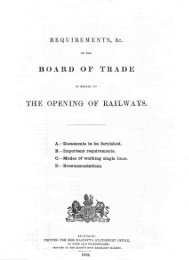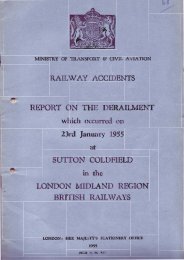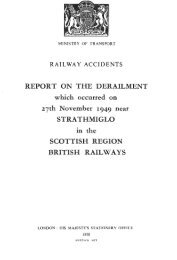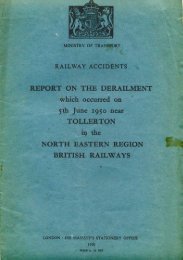R A I LT R AC K - The Railways Archive
R A I LT R AC K - The Railways Archive
R A I LT R AC K - The Railways Archive
You also want an ePaper? Increase the reach of your titles
YUMPU automatically turns print PDFs into web optimized ePapers that Google loves.
Route characteristics<br />
DESCRIPTION <strong>The</strong> Derby to Bristol and Didcot via Birmingham Line is a prime<br />
strategic route for Railtrack, providing a key element of the rail infrastructure<br />
linking the North East of England with the South West and Southern England via<br />
the Midlands. <strong>The</strong> route competes principally with the M5 from the West<br />
Midlands to Bristol, the M40 from Birmingham to the Thames Valley and the<br />
M42/A42/M1 from the Midlands to the North East.<br />
This route is primarily two track with some sections of four track around<br />
Burton upon Trent, Kingsbury to Birmingham and around Tyseley. Linespeed is<br />
90mph Derby–Water Orton and Leamington Spa–Didcot with 100mph<br />
Bromsgrove–Bristol Parkway but elsewhere 60–75mph. Linespeed on slow lines<br />
is 30–45mph. <strong>The</strong> Coventry–Leamington Spa Corridor consists of a single track.<br />
BOTTLENECK ANALYSIS <strong>The</strong> 1998 NMS identified four bottlenecks on<br />
this route:<br />
Derby–Birmingham New Street Customer growth proposals are principally<br />
from our freight customers and Virgin CrossCountry who wish to double their<br />
services. High levels of freight growth are predicted between Water Orton and<br />
Birmingham. All of these aspirations can be accommodated by the existing<br />
infrastructure.<br />
Birmingham New Street–Kings Norton This two-track section carries an<br />
intensive urban passenger service and a growing number of long-distance services<br />
operated by Virgin, Central and Wales & West. Following detailed analysis and<br />
discussion with operators we have jointly concluded that the most effectiv e<br />
solution to satisfy Virgin’s aspiration to increase the frequency of their services to<br />
Route vision<br />
<strong>The</strong> industry vision is for a key arterial route capable of handling a growing<br />
volume of passenger and freight traffic operating efficiently at different speeds<br />
across the country and at key junctions with other routes. This requires flexibility<br />
and responsiveness to potential changes in traffic mix and in meeting additional<br />
customer demand. <strong>The</strong> present route infrastructure can deliver the predicted<br />
volume of passenger and freight train services except Leamington Spa–Banbury<br />
and Oxford–Didcot. In both cases, we are proposing to increase capacity to<br />
allow for additional train movements and meet the aspirations of the Franchising<br />
Director, and of our customers. In addition, we are concluding agreement with<br />
our customers to increase linespeed across this route to obtain significant<br />
journey-time reductions by 2003.<br />
Route development and customer requirements<br />
We have consulted with our customers – the passenger and freight train<br />
operators – to determine their needs and how we evaluate them. <strong>The</strong> proposals<br />
set out in this strategy address all these aspirations for service frequency, journey<br />
times, station and depot facilities and new rolling stock.<br />
We will also examine the options to improve capacity and journey times in<br />
line with current customer aspirations, for example, a feasibility study is currently<br />
being undertaken for the development of a turnback facility at Yate.<br />
two per hour, is for Virgin’s services to use the Birmingham New Street–Camp<br />
Hill–Kings Norton route.<br />
This will achieve significant segregation of fast and stopping services in the<br />
southern approaches to Birmingham and allow all operator and market<br />
aspirations to be met by the existing infrastructure.<br />
Leamington Spa–Co ventr y This is primarily a single-track railway and usage<br />
is close to capacity. <strong>The</strong>re is the potential to accommodate additional services on<br />
this route. However, the adjacent connecting route between Coventry and<br />
Birmingham precludes this, as it is currently operating at capacity.<br />
F o l l owing detailed analysis, we have concluded with our customers, including<br />
V i rgin Trains, that to meet their aspirations for increased service frequency, it<br />
would be more appropriate to operate their proposed additional serv i c e s<br />
b e t ween Leamington Spa and Birmingham via Solihull rather than via Cove n t ry.<br />
We do not therefore propose to enhance the infrastructure on this route.<br />
However, should an increase in capacity between Birmingham and Coventry<br />
become available, we would reconsider the options for this route.<br />
Leamington Spa–Didcot Capacity on this section of route is restricted by the<br />
signal spacing between Leamington Spa and Banbury.<br />
Our analysis of future train path aspirations on this route demonstrates that,<br />
apart from Leamington Spa to Banbury, the existing infrastructure can<br />
accommodate all the projected train movements.<br />
Between Leamington Spa and Banbur y, our analysis has shown that, to meet<br />
our customers’ aspirations for additional services, we will require the provision of<br />
additional signalling. We plan to implement this by 2003.<br />
Performance reliability and efficient timetabling are key requirements. From an<br />
operator’s viewpoint, route vision would contain priority aspirations such as the<br />
introduction of new trains, and journey-time improvements with revised<br />
timetabling and service patterns.<br />
A variety of freight services are provided over this route. Overall, we<br />
expect freight traffic to expand, not only in terms of volume but also in axle<br />
weights, train lengths and vehicle profiles with an aspiration of the freight<br />
capability on the route between Didcot and Birmingham to take W10 traffic.<br />
We will continue to work with industry partners, local authorities and outside<br />
developers to improve our stations, eg at Oxford, where the downside station<br />
buildings are to be rebuilt with additional customer and retail facilities funded in<br />
partnership with Thames Trains & Virgin Trains. As well as evaluate new station<br />
opportunities, eg Charfield, we will address the ease of interchange with other<br />
transport modes, provide better car parking, real-time passenger-information<br />
systems and access for the disabled.<br />
181








